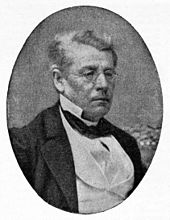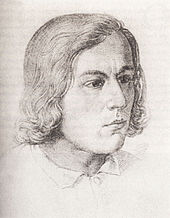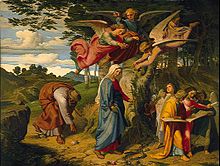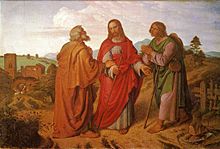Joseph von Führich

Joseph Ritter von Führich (born February 9, 1800 in Kratzau in Bohemia ; † March 13, 1876 in Vienna ), called the theologian with the pencil , was a Bohemian-Austrian painter of religious subjects ( Nazarenes ) and history painter .
Life
Führich was the son of the painter Wenzel Führich , from whom he also received his first artistic lessons. He had a total of eleven siblings, including the painter Maria Antonia Führich . In addition to his father's lessons, Führich continued his autodidactic training and caused a sensation in 1819 with two pictures at an art exhibition in Prague .
With the support of the owner of the Kratzau estate, the patron Count Christian Christoph Clam-Gallas , Führich was able to attend the Prague Art Academy . There he was u. a. the pupil of Joseph Bergler . During this course, Führich was already involved in furnishing various churches; u. a. Chanowitz, Liebenau, Nixdorf and Raspenau. He also created illustrations for works by Joseph Marius von Babo ("Otto von Wittelsbach, Count Palatine in Bavaria"), Johann Wolfgang von Goethe (" Erlkönig " and " Hermann and Dorothea "), August von Kotzebue , Friedrich Schiller , following the instructions of his teachers . Ludwig Tieck ("Phantasus"), Christoph Martin Wieland .
When Führich was in Vienna for his studies , he impressed Prince von Metternich with drawings based on Tieck's tragedy “Genoveva” (Life and Death of St. Genoveva) that he made a study trip to Rome possible for him in 1829 . There, Führich introduced himself to Friedrich Overbeck with various samples of his skills, and Friedrich Overbeck let him work on the design of the Villa Massimo from the start .
In Rome, Führich was so influenced by the Nazarenes and their religious themes that he devoted himself exclusively to the representation of religious themes and was given the affectionate nickname The Theologian with a Pencil . Führich returned to Prague around 1831 and married Franziska Gassner there the following year.
In 1834, Führich accepted a call from Metternich to Vienna to head the Countess Lambergsche Gemäldegalerie (now owned by the Academy of Fine Arts Vienna ) as curator . As such, Führich traveled to Venice in 1838 together with the painter Eduard Engerth to buy works for the gallery. Probably in gratitude for this, a chair for historical composition was set up at the art academy and Führich was appointed its first holder.
In addition to his drawings of religious content, with which Führich became known throughout Europe, oil paintings now became a further focus. In collaboration with Franz Josef Dobiaschofsky , Leopold Kupelwieser and Schulz, monumental works were created; z. B. in the Johann Nepomuk Church (Leopoldstadt) (Vienna) and the new Altlerchenfeld parish church . This work was interrupted by the March Revolution in 1848, when Führich had to flee to northern Bohemia. The Munich history painter Josef Holzmaier created the frescoes of the Stations of the Cross on the Laurenziberg in Prague based on models by Führich.
In 1851 Führich was able to return to Vienna. But since the Führich School was dissolved in the course of the restructuring of the art academy , he also lost his teaching position and title. Most of his students remained loyal to him and when Führich was given a teaching assignment again, he was able to continue teaching almost seamlessly. His most important students included Franz Josef Dobiaschofsky, Bonaventura Emler , Carl Joseph Geiger , Grünes, Caspar Jele , Klein, Lebert, Carl Madjera , Ludwig Mayer , Wenzel Ottokar Noltsch , Heinrich Reinhart , Karl Schönbrunner , Friedrich Staudinger , Stolz, Adam Vogler , Edmund von Wörndle and his brother August von Wörndle , who had been married to Führich's daughter Anna since 1872.
In 1861, Führich was raised to hereditary knighthood by Emperor Franz Joseph I. It is rumored that the emperor personally asked for suggestions on how to beautify St. Stephen's Cathedral . The designs for stained glass for it were his last work. In 1872, Führich went into well-deserved retirement with the consent of the court.
On the occasion of his 75th birthday, the artist was made an honorary citizen of the City of Vienna. The following year Joseph von Führich died on the night of March 12th and 13th, 1876 in Vienna.
Führich became internationally known for his Stations of the Cross. They spread as copper engravings and countless painters use them as templates for cross-way plates they made. Führich published a small autobiography in the Almanach Libussa as early as 1844 .
His criticism of non-religiously motivated contemporary art, which he expressed in his work Von der Kunst , was received extremely negatively by his contemporaries . The statements he made in it about the “ presently prevailing selfishness, over-education and eccentricity ” of society and art had a decisive effect on August Wilhelm Ambros .
Joseph von Führich was buried in the Grinzinger Friedhof (group 3, number 14). In the year of his death in 1876, Führichgasse was named after him in Vienna's Innere Stadt (1st district) . There is a bust of the painter in his place of birth, Kratzau . In 2001 the Austrian Post issued a special postage stamp on the 125th anniversary of Führich's death.
Works

- Outlines of Göthes Hermann and Dorothea . Vieweg, Braunschweig 1827 ( digitized edition of the University and State Library Düsseldorf )
- Moses praying with Aaron and Hur on Mount Horeb (Vienna, Austrian Gallery), 1832, oil on panel
- God writes the ten commandments to Moses on Mount Sinai on two stone tablets (Vienna, Austrian Gallery), 1835, oil on panel
- Waldesruh - Madonna and Child, St. Adelheid and St. Franziskus (Vienna, Austrian Gallery), 1835, oil on canvas, 134 × 100 cm
- Jakob meets Rachel with her father's herds (Vienna, Austrian Gallery), 1836, oil on canvas, 66 × 92 cm
- The walk to Emmaus (Bremen, Kunsthalle), 1837, oil on canvas, 29 × 44 cm
- Mary's walk over the mountains (Vienna, Austrian Gallery), 1841
- Vision of the Inhabitants of Jerusalem (Vienna, Austrian Gallery), 1844, oil on canvas
- Christ gives the keys to Peter (Esztergom, Keresztény Múzem, inv.no.55.413), 1848, oil on canvas, 95 × 78 cm
- Madonna in the Grotto (altarpiece in the Maria Magdalenen Church in Schönlinde - Krásná Lípa), 1861
- Rudolf von Habsburg and the Priest (Vienna, Austrian Gallery), 1870, oil on canvas, 111 × 135 cm
- Madonna (Esztergom, Keresztény Múzeum, inv.no.55.414), oil on canvas, 40 × 30 cm
Illustrations (selection)
- Verlag Gebrüder Mann u. a. (Ed.): Joseph Führich. The Lord's Prayer. Nine pencil drawings on the Lord's Prayer . Verlag Gebrüder Mann, 1958 (folder).
- In: Album of German artists in original etchings. - Düsseldorf: Buddeus, 1841. Digitized edition of the University and State Library Düsseldorf
literature
- Constant von Wurzbach : Führich, Joseph . In: Biographisches Lexikon des Kaiserthums Oesterreich . 5th volume, Vienna 1859.
- Joseph von Führich. A life sketch. - Internet Archive - Vienna 1875.
- Bernhard Grueber: Führich, Joseph Ritter von . In: Allgemeine Deutsche Biographie (ADB). Volume 8, Duncker & Humblot, Leipzig 1878, pp. 185-189.
- Joseph von Führich's letters from Italy to his parents. - Internet Archive - Freiburg 1883.
- Lukas Führich: Joseph von Führich. In: Graphic arts. Vienna 1886.
- Moriz Dreger: Josef Führich. Vienna: Verlag von Artaria & Co. 1912.
- Heinrich von Wörndle : Führich, Josef von . In: Ulrich Thieme (Hrsg.): General Lexicon of Fine Artists from Antiquity to the Present . Founded by Ulrich Thieme and Felix Becker . tape 12 : Fiori-Fyt . EA Seemann, Leipzig 1916, p. 558–559 ( Text Archive - Internet Archive ).
- Heinrich von Wörndle: Joseph Ritter von Führich. His life and his art. General Association of Christian Art, Munich 1925.
- Fritz Novotny: Führich, Josef Ritter von. In: New German Biography (NDB). Volume 5, Duncker & Humblot, Berlin 1961, ISBN 3-428-00186-9 , p. 688 ( digitized version ).
- Rittinger Bernhard (Ed.): Joseph Ritter von Führich, He is resurrected. The drafts for the woodcut series from 1868. Diözesanmuseum, Vienna 1991 (exhibition catalog).
- Rittinger Bernhard: Joseph von Führich, unknown nude drawings from his student days in Prague (1819–1825) . Technical University, Vienna 2000 (exhibition catalog).
- Joseph von Führich . In: General Artist Lexicon . The visual artists of all times and peoples (AKL). Volume 46, Saur, Munich a. a. 2005, ISBN 3-598-22786-8 , p. 94.
Web links
- Literature by and about Joseph von Führich in the catalog of the German National Library
- Works by and about Joseph von Führich in the German Digital Library
- Search for "Joseph von Führich" in the SPK digital portal of the Prussian Cultural Heritage Foundation
- Entry on Joseph von Führich in the Austria Forum (in the AEIOU Austria Lexicon )
- Entry on Joseph von Führich in the database of the state's memory of the history of Lower Austria ( Museum Niederösterreich )
- Führich's illustrations for Gottfried August Bürger's ballad "The wild hunter"
- Führich's illustrations for Ludwig Tieck's "Genovefa"
- New Year's apology cards from Joseph Führich
- Biography of Führich in "Life Pictures of Extraordinary Catholics of the 19th Century" by JJ Hansen completely online
Individual evidence
- ^ Josef Holzmaier . In: Hans Vollmer (Hrsg.): General lexicon of fine artists from antiquity to the present . Founded by Ulrich Thieme and Felix Becker . tape 17 : Heubel – Hubard . EA Seemann, Leipzig 1924, p. 421 .
- ^ Joseph von Führich: From the art. 4 volumes. Vienna 1866–1869. Microfiche edition: Saur, Munich a. a. 19XX, ISBN 3-598-50829-8 . In the article of the Allgemeine Deutsche Biographie wrongly cited as Über die Kunst.
- ↑ Bernhard Grueber: Führich, Joseph Ritter von . In: Allgemeine Deutsche Biographie (ADB). Volume 8, Duncker & Humblot, Leipzig 1878, pp. 185-189.
| personal data | |
|---|---|
| SURNAME | Führich, Joseph von |
| ALTERNATIVE NAMES | Führich, Joseph; Führich, Joseph Ritter von |
| BRIEF DESCRIPTION | Austrian painter of religious subjects and history painter |
| DATE OF BIRTH | February 9, 1800 |
| PLACE OF BIRTH | Chrastava , Bohemia |
| DATE OF DEATH | March 13, 1876 |
| Place of death | Vienna |




